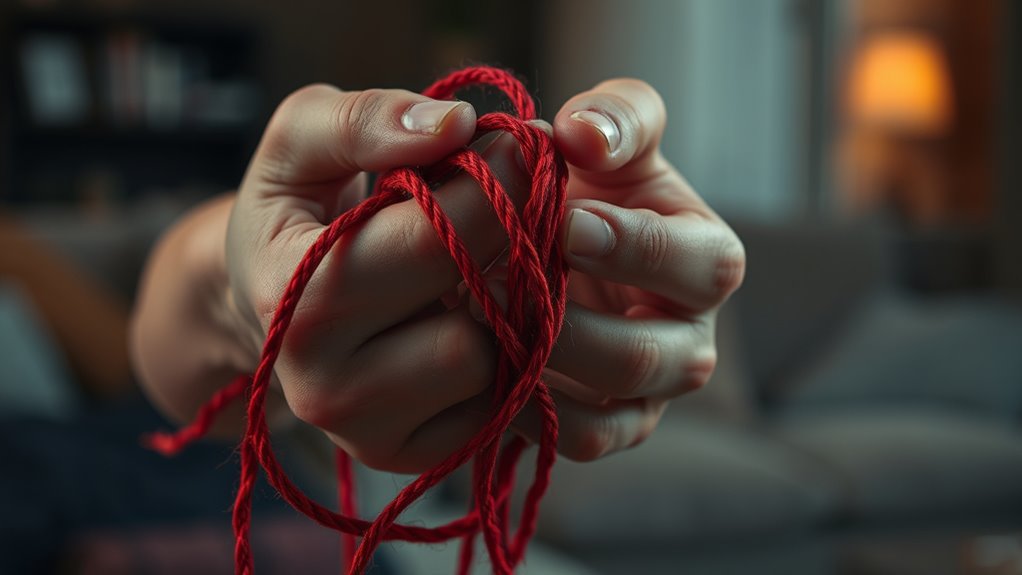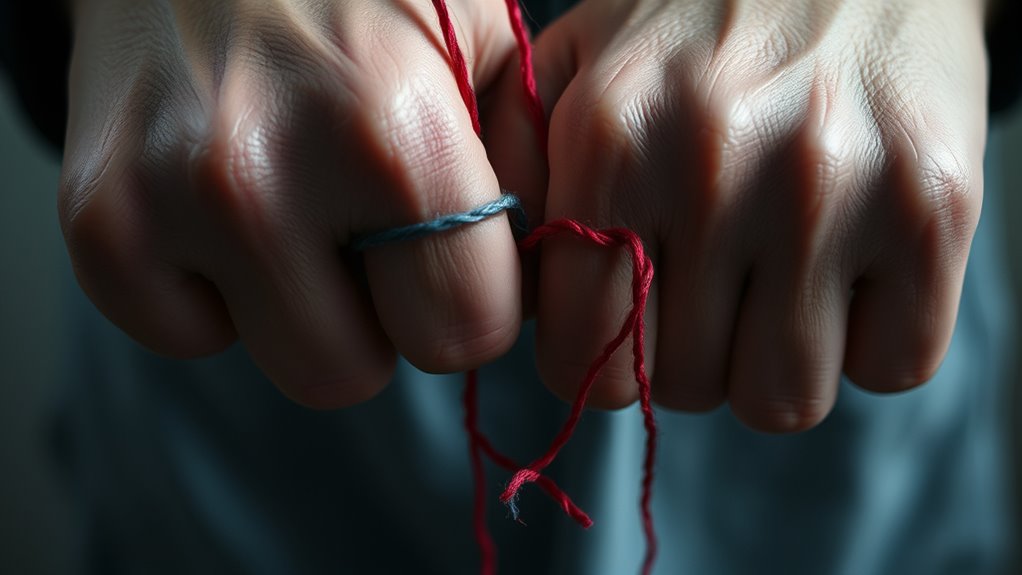If you have a high-anxiety attachment style, you probably crave love but also fear abandonment, creating a relentless loop. You seek reassurance constantly and interpret neutral actions as rejection, leading to emotional highs and lows. This cycle fuels anxiety and dependency, often making healthy boundaries seem impossible. Recognizing these patterns is the first step to breaking free. Stay with us to discover strategies that help you nurture healthier connections and build more trust.
Key Takeaways
- High-anxiety attachment causes intense craving for love paired with fear of abandonment, fueling love addiction cycles.
- Repeated reassurance-seeking reinforces emotional dependency and perpetuates the high-anxiety loop.
- Anxiety-driven behaviors lead to misinterpreting neutral actions as rejection, increasing relationship instability.
- Recognizing attachment style helps break the cycle by fostering self-awareness, boundary-setting, and healthier relationship patterns.
- Developing self-trust and understanding attachment influences are essential for overcoming love addiction.

Understanding your attachment style can be key to recognizing patterns in your relationships, especially if you find yourself struggling with love addiction. When you’re caught in a cycle of intense craving for closeness yet feeling anxious about losing it, you might be operating within a high-anxiety loop. This pattern often stems from an insecure attachment style, typically anxious or ambivalent, where you crave intimacy but also fear abandonment. It’s like constantly walking a tightrope, seeking reassurance but also feeling uneasy when it’s not immediately provided. This push-pull dynamic fuels your love addiction, making it hard to find stability or genuine connection. Instead, you become trapped in a cycle where emotional highs and lows dominate your experience, leaving you exhausted and confused about what’s real or healthy.
Recognizing high-anxiety attachment patterns helps break free from love addiction and fosters healthier, more stable relationships.
In this high-anxiety loop, your mind fixates on the idea that love and validation come from external sources. You might obsessively seek your partner’s approval, interpreting even minor signs of distance as rejection. This amplifies your fears, reinforcing the belief that you need to cling tighter to maintain the relationship. You may overanalyze every word or gesture, trying to decipher whether your partner still cares or is about to leave. The more anxious you feel, the more you seek reassurance, which often backfires, as your partner may feel overwhelmed or smothered. This reaction creates a feedback loop where your anxiety intensifies, and your efforts to secure love become more frantic and desperate. Recognizing these patterns can help you understand how attachment styles influence your behavior and emotional responses.
Your attachment style shapes how you experience and respond to these feelings. If you have an anxious attachment style, you tend to interpret neutrality as rejection and see distance as a threat. You may develop a pattern of emotional dependency, believing that your worth hinges on constant validation from your partner. This belief keeps you stuck in the high-anxiety loop, making it difficult to develop healthy boundaries or trust in yourself. Over time, this cycle can lead to love addiction, where your emotional well-being becomes dependent on the approval and presence of someone else. You might find yourself repeatedly choosing partners who reinforce these insecurities or staying in unhealthy dynamics because the familiar chaos feels more comfortable than being alone.
Breaking free from this cycle requires understanding your attachment style and recognizing these patterns early. It involves cultivating self-awareness and learning to soothe your own anxiety without relying solely on external validation. Developing a sense of self-trust and setting healthy boundaries can help you create more secure, balanced relationships. While the high-anxiety loop can feel overwhelming, awareness is the first step toward change. With effort and support, you can learn to break free from the cycle and foster healthier, more fulfilling connections. Recognizing the role of attachment style in these patterns is crucial for making lasting change.
Frequently Asked Questions
Can Love Addiction Be Cured Without Therapy?
Yes, love addiction can improve without therapy, but it’s challenging. You can start by recognizing your patterns and setting healthy boundaries. Practice self-awareness, focus on self-care, and build your self-esteem outside relationships. Seek support from friends or support groups, and educate yourself about love addiction. While therapy helps, these steps empower you to break the cycle, though lasting change often requires professional guidance.
How Do Childhood Experiences Influence Attachment Styles?
Your childhood experiences shape how you connect with others by influencing your attachment style. If you had secure relationships, you’re likely to develop healthy bonds. However, inconsistent or neglectful care can lead to anxious or avoidant attachment, affecting trust and intimacy later in life. These early interactions set patterns that influence your emotional responses and relationship behaviors, often creating the high-anxiety loop seen in love addiction.
Are Certain Attachment Styles More Prone to Love Addiction?
Did you know that nearly 60% of people with anxious attachment styles struggle with love addiction? If you have an anxious attachment style, you’re more prone to love addiction because you crave closeness and fear abandonment. You might chase validation or cling to partners, creating a high-anxiety loop. Recognizing this pattern helps you break free, build healthier relationships, and find more secure, lasting love.
What Are Effective Self-Help Strategies for High-Anxiety Attachment?
To manage high-anxiety attachment, start by practicing mindfulness and grounding techniques to stay present and reduce worry. Set healthy boundaries and communicate your needs clearly in relationships. Challenge negative thoughts and work on building self-esteem through affirmations and self-compassion. Seek therapy if needed, and focus on developing independence and trust in yourself. Consistent effort helps break the high-anxiety loop and fosters healthier attachments over time.
How Does Love Addiction Affect Long-Term Relationships?
Imagine your relationship as a delicate garden, vibrant yet vulnerable. Love addiction can cause you to overly cling, like a vine choking its support, leading to instability over time. It may intensify dependency, diminish personal growth, and create a cycle of highs and lows. Long-term, this pattern can erode trust and intimacy, leaving both partners feeling exhausted and disconnected. Recognizing and addressing love addiction helps you nurture healthier, more resilient relationships.
Conclusion
Understanding your attachment style is like holding a lantern in a dark forest—you illuminate the path of your love addiction. Recognizing the high-anxiety loop allows you to break free and rewrite your story. Remember, love isn’t a cage but a garden you cultivate. With awareness and compassion, you can transform your patterns from stormy seas into a peaceful, nurturing haven. Your journey toward healthier love begins with a single, brave step—shine your light and embrace the change.









